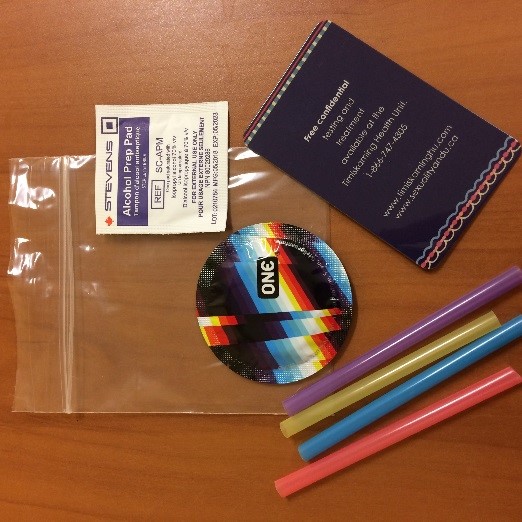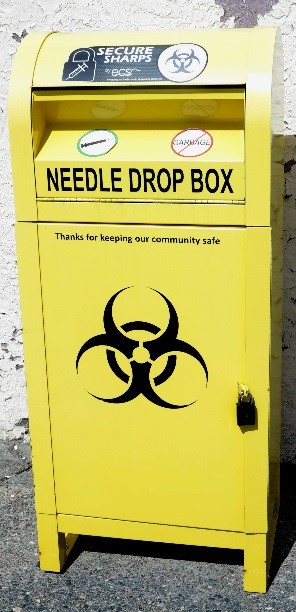
Harm Reduction Services
On this page:
The Timiskaming Health Unit’s Harm Reduction Distribution Program is designed to ensure that people who use drugs can have access to sterile injection equipment and safer inhalation kits to reduce the incidence and prevalence of HIV, Hepatitis B, Hepatitis C, and other harms. Where appropriate, clients are encouraged to take advantage of Hepatitis vaccination programs, HIV and other blood testing, counseling, overdose prevention, and referral to rehabilitation programs.
What is Harm Reduction?
Harm Reduction is a set of principles that can be used to guide policy and program development which aim primarily to reduce the adverse health, social and economic consequences associated with drug use.
Needle Exchange
- Offers sterile equipment provided by the Ontario Harm Reduction Distribution Program and other services to reduce the spread of blood-borne infections among people who use drugs.
- Protects the public by reducing the number of used needles discarded in public places.
Free Supplies and Services:
- needles, injection and inhalation equipment for injecting or inhaling drugs
- information about safer drug use
- information about safer sex
- community referrals to services
- disposal containers for used needles and sharps
- condoms and lube
- information on Naloxone and overdose prevention and management
A list of local agencies offering harm reduction services can be found here.
Naloxone
Naloxone can temporarily reverse an opioid overdose. When someone overdoses on opioids, their breathing either slows or stops completely. If used right away, naloxone can help them breathe normally and regain consciousness. Naloxone can either be injected or given as a nasal spray. Naloxone is provide free of charge at all Timiskaming Health Unit offices to those who use, and friends and family of those who use substances.
Resources:
Safer Injecting Equipment
The Timiskaming Health Unit provides safer injecting equipment to reduce the risks associated with sharing injection equipment including needles.
Supplies Available:
- sterile alcohol swabs
- sterile water ampoules
- cookers/spoons
- filters
- ascorbic acid
- tourniquets
Resources:
Safer Smoking Supplies:
Distribution of safer smoking supplies reduces the risk that people will share pipes or use broken pipes. The Timiskaming health unit distributes supplies for the safer smoking of drugs such as crack and crystal meth.
Supplies available:
- stems
- bowl pipes
- mouthpieces
- screens
- push sticks
- sterile alcohol swabs
- foil
Resources:
Safer Snorting Kits
 Hepatitis C and other blood borne diseases are spread through infected blood. Snorting drugs can damage the inside lining of your nose causing it to become raw and irritated. When snorting, tiny blood vessels inside the nose can break and cause small amounts of blood to leak. For people who snort drugs that means that using rolled bills for snorting can be a risky activity. You may risk infecting someone or becoming infected yourself if you share straws or bills with someone who is Hepatitis C positive.
Hepatitis C and other blood borne diseases are spread through infected blood. Snorting drugs can damage the inside lining of your nose causing it to become raw and irritated. When snorting, tiny blood vessels inside the nose can break and cause small amounts of blood to leak. For people who snort drugs that means that using rolled bills for snorting can be a risky activity. You may risk infecting someone or becoming infected yourself if you share straws or bills with someone who is Hepatitis C positive.
The Timiskaming Health Unit has safer snorting kits to help reduce the risk of harms. Each kit contains:
- Four straws of different colours
- A hard plastic card
- Condom
- Sterile alcohol swabs
Resources:
Collection and Disposal of Sharps 
Sharps such as needles, razors or broken glass equipment should be disposed of in approved containers, and not municipal waste. Approved sharps containers are available through the Timiskaming Health Unit and local participating pharmacy locations.
If any sharps waste is found in the community including needles:
- Treat all needles and crack pipes (glass stems) as contaminated.
- Wear gloves (i.e. latex, rubber or leather gardening gloves). Gloves are meant to protect against fluid contamination, not punctures or cuts.
- Use tongs, pliers or tweezers to pick up the needle. Be sure to clean and disinfect the pickup instrument afterwards.
- Put the sharps disposal container on a stable surface next to the needle. Do not hold the container in your hand while placing the needle inside.
- Pick up the needle by the plastic end (barrel).
- Point the needle tip away from your body. Be very careful not to poke yourself with the needle.
- Place the needle point down into the container. Do not force the needle into the container.
- If you do not have a specialized sharps container, put the needle into a non-breakable, puncture-proof container with a lid. (i.e. thick plastic bottle or tin can.)
- Close the container securely.
- Find the nearest needle disposal location. Do not flush needles down the toilet or put them in the garbage or recycling bin.
- Wash your hands or use hand sanitizer after removal of gloves.
If a needle injury occurs, seek immediate medical attention.
For more information please follow this guide - What to do if you encounter a needle or other drug paraphernalia
Needle drop boxes are located at the Timiskaming Health Unit offices in New Liskeard at 247 Whitewood Avenue and in Kirkland Lake at 31 Station Rd North.
Remember: Never throw needle waste in the garbage, recycling, or down the toilet.
Safe Sharps Disposal Bin Locations
|
THU New Liskeard
Bin
|
New Liskeard
|
247 Whitewood
Avenue
|
by front entrance of the health unit office.
|
|
CMHA Bin
|
New Liskeard
|
20 May Street
South
|
by front entrance
of CMHA building
|
|
THU Bin Kirkland
Lake
|
Kirkland Lake
|
31 Station Road
North
|
by front entrance
of the health unit office.
|
|
Englehart Hospital
Bin
|
Englehart
|
61-5th Street
|
outside emergency
department entrance of Blanch River Health hospital
|
|
CSCT
|
Larder Lake
|
17 Godfrey Street
|
outside front
entrance
|
|
CSCT
|
Virginiatown
|
61 Connell Avenue
|
outside front
entrance
|

20240625/kp:nd